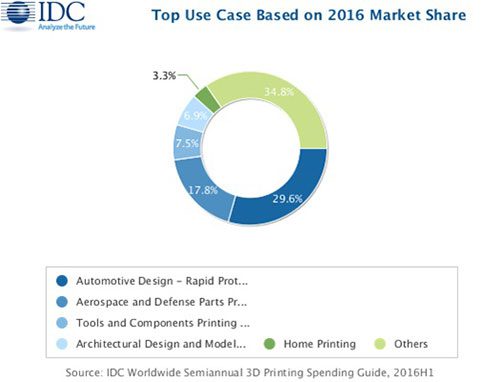Whether they pump out parts themselves or contract with on-demand services, business demand for 3D printed objects will push the market to more than twice the size of what it is today. IDC’s just-released forecast predicts that worldwide spending on 3D printers, along with the associated software, materials and services, will reach $28.9 billion in […]
Datamation content and product recommendations are
editorially independent. We may make money when you click on links
to our partners.
Learn More
Whether they pump out parts themselves or contract with on-demand services, business demand for 3D printed objects will push the market to more than twice the size of what it is today.
IDC’s just-released forecast predicts that worldwide spending on 3D printers, along with the associated software, materials and services, will reach $28.9 billion in 2020, compared to an estimated $13.2 billion in 2016. That lofty figure represents a compound annual growth rate (CAGR) of 22.3 percent over the five-year forecast period.
Unsurprisingly, the discrete manufacturing industry will be firmly in control of the market, responsible for more than two thirds of revenues for the foreseeable future.
Last fall, Gartner predicted that by 2020, 65 percent of discrete manufacturers would use 3D printers to produce components for the products they sell or support. “Aircraft and aerospace manufacturers have been taking this approach for years, using 3D printers to produce low-volume parts and small lots of parts with complex designs,” commented Gartner research vice president Pete Basiliere.”

Medical companies in the United States and Western Europe will push healthcare into the number two spot by 2020 with revenues of more than $3.1 billion, said IDC.
“Thanks to the broader variety of 3D printers and materials that can be used, and also to lower prices, 3D printing is becoming more sophisticated and devoted to newer uses,” remarked IDC research analyst Carla La Croce in a statement. “In addition, existing use cases are increasing their market share. For example: dental printing is growing rapidly with the prospect of reaching one of the highest market shares in the near future (around 15 percent in 2020), as well as 3D printing for medical implants and devices (nearly 13 percent in 2020).”
For 2016, the automotive design rapid prototyping segment is estimated to have generated $3.9 billion in revenues. The aerospace and defense parts printing category follows with nearly $2.4 billion.
Businesses will snap up 3D printers and the materials required to produce physical objects. Combined, they will attract nearly two-thirds of revenues, said IDC. The research firm also expects a big uptick in computer-aided design (CAD) software sales, tripling by 2020.
The United States is poised to lead the market, generating a quarter of 3D printing revenues. Western Europe, Asia-Pacific excluding Japan, and Japan are expected to follow with just over half of total revenues combined.
Pedro Hernandez is a contributing editor at InfoStor. Follow him on Twitter @ecoINSITE.
-
Ethics and Artificial Intelligence: Driving Greater Equality
FEATURE | By James Maguire,
December 16, 2020
-
AI vs. Machine Learning vs. Deep Learning
FEATURE | By Cynthia Harvey,
December 11, 2020
-
Huawei’s AI Update: Things Are Moving Faster Than We Think
FEATURE | By Rob Enderle,
December 04, 2020
-
Keeping Machine Learning Algorithms Honest in the ‘Ethics-First’ Era
ARTIFICIAL INTELLIGENCE | By Guest Author,
November 18, 2020
-
Key Trends in Chatbots and RPA
FEATURE | By Guest Author,
November 10, 2020
-
Top 10 AIOps Companies
FEATURE | By Samuel Greengard,
November 05, 2020
-
What is Text Analysis?
ARTIFICIAL INTELLIGENCE | By Guest Author,
November 02, 2020
-
How Intel’s Work With Autonomous Cars Could Redefine General Purpose AI
ARTIFICIAL INTELLIGENCE | By Rob Enderle,
October 29, 2020
-
Dell Technologies World: Weaving Together Human And Machine Interaction For AI And Robotics
ARTIFICIAL INTELLIGENCE | By Rob Enderle,
October 23, 2020
-
The Super Moderator, or How IBM Project Debater Could Save Social Media
FEATURE | By Rob Enderle,
October 16, 2020
-
Top 10 Chatbot Platforms
FEATURE | By Cynthia Harvey,
October 07, 2020
-
Finding a Career Path in AI
ARTIFICIAL INTELLIGENCE | By Guest Author,
October 05, 2020
-
CIOs Discuss the Promise of AI and Data Science
FEATURE | By Guest Author,
September 25, 2020
-
Microsoft Is Building An AI Product That Could Predict The Future
FEATURE | By Rob Enderle,
September 25, 2020
-
Top 10 Machine Learning Companies 2021
FEATURE | By Cynthia Harvey,
September 22, 2020
-
NVIDIA and ARM: Massively Changing The AI Landscape
ARTIFICIAL INTELLIGENCE | By Rob Enderle,
September 18, 2020
-
Continuous Intelligence: Expert Discussion [Video and Podcast]
ARTIFICIAL INTELLIGENCE | By James Maguire,
September 14, 2020
-
Artificial Intelligence: Governance and Ethics [Video]
ARTIFICIAL INTELLIGENCE | By James Maguire,
September 13, 2020
-
IBM Watson At The US Open: Showcasing The Power Of A Mature Enterprise-Class AI
FEATURE | By Rob Enderle,
September 11, 2020
-
Artificial Intelligence: Perception vs. Reality
FEATURE | By James Maguire,
September 09, 2020
SEE ALL
APPLICATIONS ARTICLES
Pedro Hernandez is a contributor to Datamation, eWEEK, and the IT Business Edge Network, the network for technology professionals. Previously, he served as a managing editor for the Internet.com network of IT-related websites and as the Green IT curator for GigaOM Pro.










